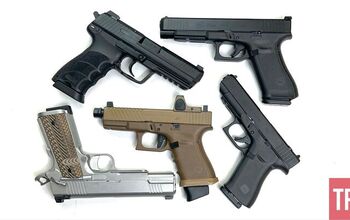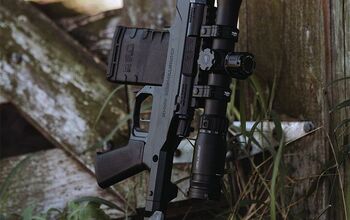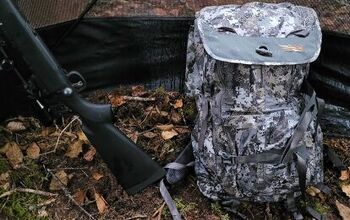TFB Review: Nightforce 4.5x Competition Service Rifle Scope

For those who shoot in high power service rifle matches, the dedicated Nightforce scope for that game needs no introduction. It is a common sight on the rifles of people who can afford the best equipment. When Nightforce hit me up with the opportunity to try it out I enthusiastically said yes.
CMP @ TFB:
- CMP Adds Mid-Range Events To National Matches
- Getting Started in CMP Service Rifle Competition
- CMP Announces Action Pistol Competitions, Other Rule Changes For 2023
- New Rules for the 2022 CMP Smallbore Rifle Competition
- CMP Plans Surplus Ammunition Sale in Spring
Disclosures need to be included in any review. Nightforce reached out and offered to loan me the scope and mount for the review. I paid for the ammo and match fees. This is my first review for Nightforce but I have worked with their sister company Horus on a few reviews previously.
Design & Features
Competition service rifle shooting was traditionally a game played with iron sights. That changed in 2016 when scopes were allowed. Various manufacturers started making scopes optimized for the CMP rules, which limit maximum magnification to 4.5x. I have no idea why 4.5x was selected, rather than just 4x like the standard military ACOG, but it was. Every feature of this scope is designed for this specific type of competition. The magnification is fixed at 4.5 power instead of the more common 4x of regular scopes. That extra 1/2 power may not sound like much, but it’s about 12% more magnification than a 4-power scope.
This particular Nightforce scope has a reticle specifically designed for this game. There are three posts at the 3-, 6-, and 9-o’clock positions for vertical and horizontal references, all pointing at the center aiming point. It has a 10 MOA inner circle that sits around the aiming black like an old-school aperture target sight. Inside that circle is an 8 MOA crosshair, which leaves a little bit of crosshair to poke out of the aiming black on each side (size of aiming black: 13 inches at 200 yards = 6.5 MOA, 19 inches at 300 yards = 6.3 MOA, and 36 inches at 600 yards = 6 MOA).
When everything is lined up correctly this is a very simple sight picture. It also lends itself to precise hold-offs when dialing in a correction isn't advisable. For example, during a rapid fire string, a wind change could require a little extra windage, and dialing would take too long. While the outer circle is still surrounding the aiming black, letting some extra crosshair show on the appropriate side is a repeatable correction.
Setup
Mounting the Nightforce Competition Service Rifle scope was uneventful. Nightforce also supplied the appropriate cantilever mount, called the XTRM Ultramount SR. It extends further forward than regular cantilever mounts which is ideal for the positions used in high power competition. They sell two height options and I opted for the taller one because I have a very large head.
The tracking was perfect during zeroing, with my shot groups moving exactly the expected amount with each change. Resetting the turrets was also very easy. Each turret is held in place with one substantial screw, and unlike the cheaper hardware found on lesser scopes, it would be very hard to strip it out.
The turrets themselves are excellent. The markings are easy to read at a glance. When turning the turrets, the clicks are in the sweet spot of clicky/tactile enough to be easily felt and counted, but easy enough to change quickly without too much effort. I would not change anything about them.
Impressions
The quality of the glass is readily apparent. The resolution, clarity, and light transmission all feel on-point for a top-tier scope like this. I have quipped to customers in the gun store that the problem with shooting nice scopes is that they make you less satisfied with cheaper scopes.
While ultra clarity is not all that important for target identification (we shoot at big black bullseye targets on light backgrounds with large numbers in front), one place where great glass matters is in spotting mirage, which is one of the key indicators for wind reading. Most high power shooters use a large spotting scope to watch for changes in the mirage which signal changes in the wind, but looking back and forth between the spotter and the rifle scope leaves a gap where wind conditions can change without being noticed. That risk is reduced with the Nightforce SR because it does a good job of still picking up mirage downrange. It is not as good as a massive spotter with an 85mm objective lens, but it is useful enough that I caught several mirage changes in the rifle scope that I would have missed with lesser glass. Missing those wind shifts in the past (when I shot irons or other optics) cost me a lot of points. Now, this is not to say I was a perfect wind reader thanks to this scope, but it helped me catch enough of those changes that it helped me save a few points.
Another great feature is the reticle design. It is simply intuitive to use, and the reticle works like a champ. The outer ring feels like using diopter iron sights with the circle sitting nicely around the aiming black. The crosshair gives both an easily visible and precise aiming point as well as a quick and dirty way to measure a hold-off in a pinch.
Pictures through scopes are always a little fraught because they are not perfect representations. Adding another group of lenses behind the scope rather than an eye adds some extra variables. But it is the best way to share the experience of being behind the scope without mailing it to you, so here are a few pictures.
In Practice
I took the Competition Service Rifle scope out for zeroing and practice a few times before the season started. That meant shooting outside in the snow for distance work, and indoors with a .22 LR conversion kit.
During one range trip, my rifle was leaned up against a wall while I was shuffling gear. Unsurprisingly, I bumped it and it fell over. While it was not a long drop, my rifle weighs about 15 pounds so it hit the ground very hard. True to reputation, the Nightfore shrugged it off and my zero was unaffected. Nightforce scopes are built for the battlefield, so the “rigors” of competition are tame in comparison.
The fixed parallax of the Nightforce Competition Service Rifle scope makes sense for what the scope is made to do. It's one less thing to have to remember to set between stages at a match. The trade-off is that there is no adjustment for close-range practice. I work at and have access to a 25-yard indoor range, and with a .22LR conversion bolt, I can get some very affordable training done while the snow is deep. Adjustable parallax would make for a clearer image and less error during that practice. But it would also be one more mechanism that could break or something I would eventually forget to change and would screw up a rapid-fire string.
In Competition
The ultimate test of this kind of scope is using it in the competition it was designed for. My first match was supposed to be a CMP Excellence in Competition (EIC) match, but it ended up being a practice match due to poor turnout. The Competition Service Rifle scope worked well and was nice, but it is easy to have good things to say when the pressure is off and the shooting is just for fun.
Fortunately, the next match was the real deal. As with all EIC matches, there are no sighting shots, you shoot every shot for score and you better hope your scope holds zero. I started off strong in offhand, and things continued well in the rapid-fire stages. I intentionally avoided adding up my score from the first three stages and focused on executing the 600 yard slow fire stage. I caught most of the wind changes thanks to a careful eye on the flags and the ability to see mirage downrange without looking away from the scope.
At the end of the day, I shot a score of 470/500. That’s my personal best, and it was good enough to snag my first points toward the rank of Distinguished Rifleman. I have been slowly improving as a shooter so that was not due solely to the scope, but it certainly helped! Seeing clearly what you are shooting at makes it a whole lot easier to place shots where you want them.
Conclusion
There is a reason the Nightforce Competition Service Rifle scope is a standard issue item for the Army Marksmanship Unit. It is a superb optic. High power service rifle is traditionally a working man's competition where competitive equipment doesn't require a second mortgage. The Nightforce SR is exceptional, but that comes at a price. But if you are taking time off work, driving two states over, and paying for a hotel and meals all so you can shoot in a match, it's also very expensive to have an equipment failure that renders all those other expenses wasted.
This is the rare review where I can't find a fault in a product, other than the price. If money is no issue and you love shooting service rifle matches, this is the scope to get. If you are just starting out and need a dedicated scope for this game, the price increase over other scope options is probably better spent on practice ammo and range fees. However, the Nightforce is one you will not need to upgrade down the line. If you can afford it this is the scope to beat. And after using it in matches, I decided to pay them for it rather than sending it back.
Nightforce Competition SR Fixed 4.5x24 Scope
We are committed to finding, researching, and recommending the best products. We earn commissions from purchases you make using the retail links in our product reviews. Learn more about how this works.

AKA @fromtheguncounter on Instagram. Gun nerd, reloader, attorney, and mediocre hunter.
More by Daniel Y



































![[Partner 2025] Zastava Unveils New Machinegun Chambered in 6.5 Grendel](https://cdn-fastly.thefirearmblog.com/media/2025/09/28/05281/partner-2025-zastava-unveils-new-machinegun-chambered-in-6-5-grendel.jpg?size=350x220)






Comments
Join the conversation
Why in the world would you want to put ANY 4.5x scope on a shotgun?
Congratulations on the leg points. I am old school as well as old, got my Distinguished badge using irons back in 2005. I have an Athlon scope now for Service Rifle Competition and it’s lousy. Clicks are too mushy to define and the reticle does not have the proper characteristics to understand exactly where the rifle is pointed. At any rate, I should have bought the NF scope.